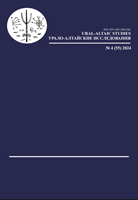Полисемия сравнительного маркера kad' в татышлинском говоре удмуртского языка
Polysemy patterns of the equative marker kad' in Tatyshly Udmurt
Author(s): Daria Mordashova, Maria Emilia A. Winkler, Julia V. SinitsynaSubject(s): Morphology, Lexis, Semantics, Historical Linguistics, Descriptive linguistics
Published by: Институт языкознания Российской академии наук
Keywords: comparative markers; equative constructions; simulative constructions; quantified expressions; approximative markers; epistemic modals; semantics; hedges; typology; Udmurt; Uralic languages;
Summary/Abstract: The aim of the paper is to study the functionality of the comparative marker kad' in Tatyshly Udmurt (< Permic < Uralic). We show that the marker under study develops a broad polysemy network: it can be used in comparative constructions of equality (CoE); in quantified expressions (to mark an approximate numerical meaning); in constructions with the debitive participle ending in -ono; as a complementizer for verbs like 'appear' and 'pretend'; as a modal particle (to mark epistemic modality and reportative evidentiality). The paper provides a theoretical explanation for this pattern of polysemy based on the primary equative meaning of the marker kad'. The latter is considered as an operator introducing a comparison with some standard, which can be explicitly specified (for CoE and quantified expressions, as well as for constructions with a participle ending in -ono) or calculated from the context (in the function of a complementizer or a particle marking irrealis). We argue that in all cases kad' deals with the scale that shows the correspondence between the observed event and the standard one that the speaker uses to describe the situation. This allows us to classify kad' as a hedge whose main function is to widen the pragmatic halo of an expression. In addition, the paper provides a typological evaluation of the Tatyshly Udmurt data. Although the development of equativeapproximative polysemy and the epistemic meaning of such markers are not widely discussed in the typological literature, the Tatyshly Udmurt data are not unique. Parallels from some Uralic and Turkic languages are provided.
Journal: Урало-алтайские исследования
- Issue Year: 2024
- Issue No: 04 (55)
- Page Range: 90-112
- Page Count: 23
- Language: Russian

